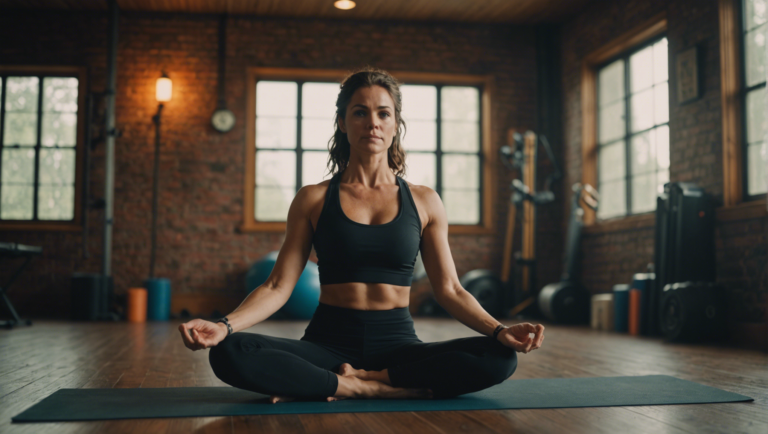Guidelines On How To Assess Your Feelings After A Yoga Class
Importance of Reflecting on Emotions Post-Yoga Practice
Now, let’s delve into the importance of reflecting on emotions after participating in a yoga practice.
Understanding the Significance of Self-Reflection Post-Yoga Class
After completing a rejuvenating yoga session, taking the time to assess your emotions and mental state is crucial. Yoga is not just a physical practice but also a holistic approach to well-being that integrates the mind, body, and spirit. Reflecting on your feelings after a yoga class allows you to deepen your self-awareness, gain insights into your emotional responses, and track your progress on a mental and emotional level.
Recognizing Emotional Shifts and Responses
As you unwind from the physical exertion of yoga, pay attention to any shifts in your emotional state. You may experience a sense of tranquility, inner peace, or heightened awareness. Conversely, you might also notice feelings of frustration, restlessness, or irritability. By acknowledging and accepting these emotions without judgment, you can cultivate a greater sense of emotional intelligence and resilience.
Cultivating Mindfulness and Presence
Engaging in post-yoga reflection fosters mindfulness and presence in the moment. By tuning into your emotions without trying to modify or suppress them, you develop a deeper connection with your inner self. This practice of self-reflection not only enhances your yoga experience but also extends to your daily life, enabling you to navigate challenges with greater composure and clarity.
Enhancing Self-Awareness and Personal Growth
Self-reflection after a yoga class serves as a powerful tool for self-discovery and personal growth. By observing your emotional responses to different poses, sequences, or breathing techniques, you gain valuable insights into your patterns of thinking and behavior. This heightened self-awareness empowers you to make conscious choices that align with your values and aspirations, fostering holistic well-being.
Integrating Emotional Wellness Into Your Yoga Journey
Emotional well-being is an integral aspect of the yoga journey, and self-reflection plays a pivotal role in nurturing this aspect. By regularly assessing your feelings post-yoga practice, you create space for emotional release, self-care, and self-compassion. This practice not only deepens your connection with yourself but also enhances the therapeutic benefits of yoga on a mental and emotional level.
In essence, reflecting on your emotions after a yoga class is a transformative practice that enriches your yoga experience and promotes holistic well-being. By embracing your emotions with mindfulness and self-compassion, you embark on a journey of self-discovery, personal growth, and emotional resilience. So, the next time you roll up your yoga mat, take a moment to pause, breathe, and explore the profound insights waiting to be discovered within.
Techniques for Mindful Self-Assessment After Yoga Sessions
Practicing yoga can have a profound impact on both the body and mind, leaving you feeling relaxed, balanced, and rejuvenated. After a yoga session, it is essential to take the time to assess your feelings and reflect on the practice. This mindful self-assessment can provide valuable insights into your physical, mental, and emotional well-being, helping you to track your progress, set goals, and make adjustments to your practice as needed.
Reflecting on Your Physical Sensations
After completing a yoga class, take a few moments to tune in to your body and notice any physical sensations you may be experiencing. Pay attention to areas of tension or tightness, as well as any feelings of openness, lightness, or ease. Take note of how your body feels overall – whether you feel energized, fatigued, or somewhere in between. This awareness can help you identify areas of strength and flexibility that may be improving, as well as areas that may require more attention or modification in future practices.
Observing Your Breath and Energy Levels
The breath is a fundamental element of yoga practice, serving as a bridge between the body and mind. Notice the quality of your breath after class – is it steady and smooth, or choppy and uneven? Observing your breath can offer insights into your energy levels, stress levels, and emotional state. If you find that your breath is erratic or shallow, it may indicate that you are holding onto tension or struggling with racing thoughts. By focusing on deep, intentional breathing, you can calm the mind and bring a sense of balance back to your energy.
Evaluating Your Emotional State
Yoga has the power to stir up emotions and memories that may be lingering beneath the surface. Take time to check in with your emotional state after a yoga session. Do you feel calm, centered, and grounded, or are you experiencing waves of emotion like sadness, frustration, or joy? Recognizing and acknowledging your emotions without judgment is an essential part of the self-assessment process. It can help you cultivate greater self-awareness, acceptance, and compassion towards yourself and others.
Setting Intentions for Future Practices
After reflecting on your physical, mental, and emotional experiences, consider setting intentions for your future yoga practices. These intentions can be as simple as focusing on self-care, cultivating gratitude, or working towards a specific pose or goal. By establishing clear intentions, you can infuse your practice with purpose and meaning, ultimately enhancing the benefits you receive from each session. Remember to revisit these intentions regularly and adjust them as needed to support your growth and evolution on and off the mat.
Mindful self-assessment after a yoga class is a powerful tool for deepening your practice and fostering self-awareness. By tuning into your physical sensations, breath, emotions, and intentions, you can gain valuable insights that will support your journey towards holistic well-being. Remember that yoga is a personal practice, and your feelings and experiences are unique to you. Embrace the process of self-assessment with an open heart and a curious mind, allowing yourself to learn and grow with each practice.
Identifying Physical and Emotional Cues After a Yoga Class
Journaling as a Tool for Evaluating Post-Yoga Feelings
Integrating Feedback from Yoga Instructors to Enhance Self-Reflection
Yoga instructors play a crucial role in guiding practitioners through their yoga journey, providing valuable feedback that can significantly enhance self-reflection and personal growth. Integrating feedback from yoga instructors can be a powerful tool in deepening one’s practice and gaining a better understanding of oneself both on and off the mat.
Importance of Feedback in Yoga Practice
Feedback from yoga instructors serves as a mirror that reflects our practice back to us. It offers valuable insights into our alignment, breath control, and overall performance during a yoga class. By actively listening to and internalizing this feedback, practitioners can make necessary adjustments to improve their practice continually.
Enhancing Self-Reflection through Feedback
When receiving feedback from a yoga instructor, it is essential to approach it with an open mind and a willingness to learn. Instead of taking feedback personally, view it as an opportunity for growth and self-improvement. Reflect on the feedback provided, and consider how you can apply it to your practice both in the present moment and in future sessions.
Building Trust and Connection with Instructors
Developing a strong rapport with your yoga instructors can create a safe and supportive environment for receiving feedback. Building trust and connection with instructors allows for more open communication and a deeper understanding of the guidance provided. This connection can foster a positive feedback loop where both the instructor and practitioner benefit from ongoing dialogue and reflection.
Implementing Feedback into Daily Practice
Integrating feedback into your daily yoga practice involves more than just making physical adjustments. It also requires emotional and mental reflection. Consider the underlying messages behind the feedback received – perhaps it is about finding more balance, letting go of perfectionism, or cultivating a sense of presence and mindfulness. By incorporating these subtler aspects into your practice, you can deepen your self-awareness and connection to the practice of yoga.
Setting Personal Goals and Intentions
Feedback from yoga instructors can help practitioners set personal goals and intentions for their practice. Whether it is improving flexibility, building strength, or cultivating a sense of inner peace, feedback can highlight areas for growth and provide direction for setting meaningful goals. By aligning your practice with your intentions and aspirations, you can stay motivated and focused on your path of self-discovery through yoga.
Integrating feedback from yoga instructors is a valuable tool for enhancing self-reflection and personal growth in your yoga practice. By approaching feedback with openness, trust, and a willingness to learn, practitioners can deepen their practice, set meaningful goals, and cultivate a deeper connection to themselves both on and off the mat. Embrace feedback as a gift that can propel you forward on your yoga journey towards greater self-awareness and holistic well-being.
Conclusion
The valuable aspects learned during a yoga practice into your daily life requires mindful reflection on the emotions experienced after each session. By recognizing the importance of reflecting on your feelings post-yoga, you pave the way for a deeper understanding of yourself and your practice. This introspection allows for personal growth and serves as a gateway to better emotional and physical well-being.
Utilizing techniques for mindful self-assessment post-yoga sessions can significantly enhance your overall experience. By taking the time to sit quietly and tune into your thoughts and emotions, you create space for self-awareness and introspection. Mindful breathing exercises can further assist in grounding yourself and fostering a sense of inner peace, making it easier to identify and process your emotions effectively.
Pay attention to the physical and emotional cues that arise after a yoga class. Notice how your body feels, any areas of tension or release, and any emotions that come to the surface. Acknowledging these cues can provide valuable insights into how your body and mind respond to the practice, allowing you to make adjustments as needed to support your overall well-being.
Journaling serves as a powerful tool for evaluating your post-yoga feelings. By recording your thoughts, emotions, and physical sensations after each session, you create a tangible record of your journey. Reflecting on these journal entries over time can help you track patterns, identify areas of growth, and gain a deeper understanding of yourself and your practice.
Integrating feedback from yoga instructors can further enhance your self-reflection process. Seeking input from knowledgeable and experienced instructors can offer valuable perspectives on your practice, helping you gain insights into areas for improvement and growth. By incorporating their feedback into your self-assessment, you can refine your practice and deepen your understanding of the mind-body connection.
The practice of assessing your feelings after a yoga class is crucial for personal growth and self-awareness. By recognizing the significance of post-yoga reflection, utilizing mindful self-assessment techniques, identifying physical and emotional cues, journaling your experiences, and integrating feedback from instructors, you set the stage for a transformative journey of self-discovery and holistic well-being. Embrace this process wholeheartedly, and allow it to guide you towards a deeper connection with yourself and your practice.

